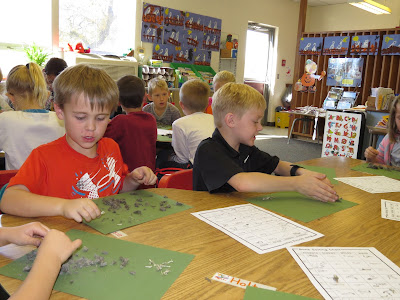We decided to display our learning while helping to teach others in our school about owls. I taught a step-by-step owl drawing lesson. I will add a photo of that tomorrow. Next, we discussed which facts to share. This display is in our hallway. This will be good review for past kindergarten students too.
A couple of days ago I did a PowerPoint slideshow teaching the kindergarten and 2nd grade students about the owls of South Dakota. I displayed a photo and played the song/call of each owl. They quickly learned that not all owls hoot. I also showed some photos of the prey that owls eat.
I explained how owls cannot digest the fur and bones of their prey, so they cough it up in the form of a pellet. Next, I gave each kindergartner a pellet and they pulled it apart removing the bones. They compared the bones that they discovered to that on a chart. It was mostly rodents and a couple of birds.
I imagine that you are thinking that this is gross, but kids seem to find it fascinating and so do I. It is a good learning experience because it teaches students about anatomy, the food chain and it gets them thinking deeper by piecing the puzzle together. Its a bit like being a detective. The students were all actively engaged in the activity and having great conversations about what they were finding. Kids thinking and asking good questions...this is what teachers love to see!
 |
| They compared the bones to the sorting chart. |
 |
| The looks on their faces made me smile. |
 |
| The bones were quite tiny. |
 |
| "Look! A skull!" |
 |
| The 2nd graders and K-kids worked well together! |
 |
| Here's the crew! They are hard at work! |
I'll just bet none of you K-kids knew you'd learn the meaning of the word 'anatomy' while in kindergarten! How smart you already are! I'd never even seen an owl pellet until I was grown up, and here you're dissecting them! You're so lucky!!
ReplyDelete